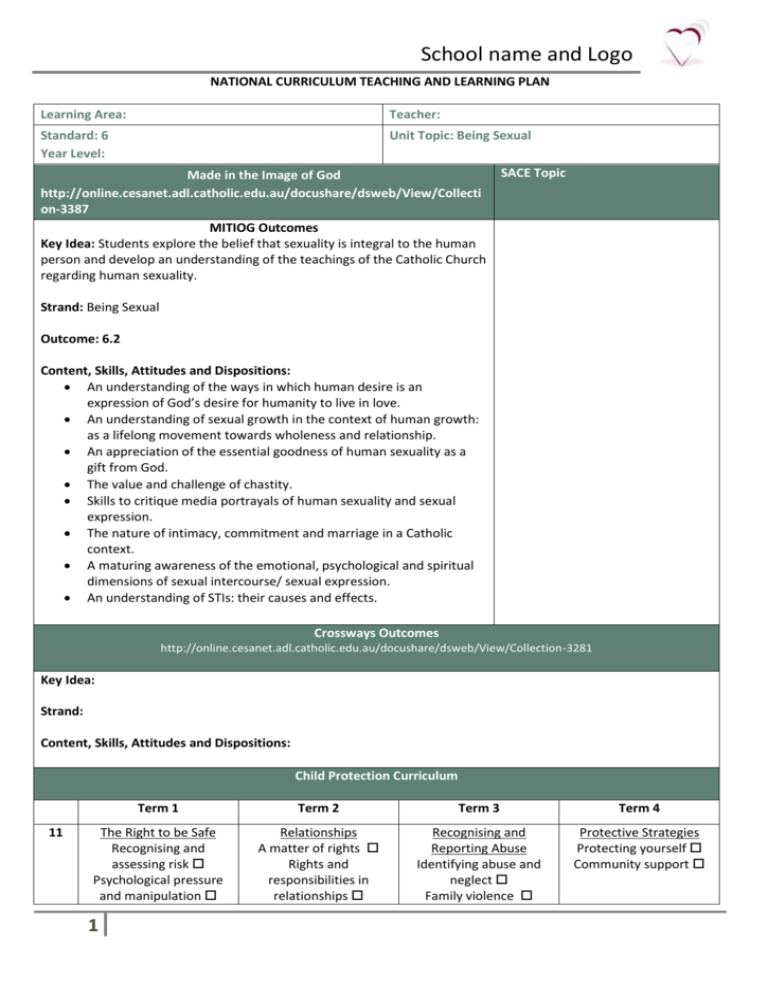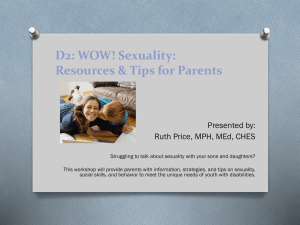
School name and Logo
NATIONAL CURRICULUM TEACHING AND LEARNING PLAN
Learning Area:
Teacher:
Standard: 6
Year Level:
Unit Topic: Being Sexual
SACE Topic
Made in the Image of God
http://online.cesanet.adl.catholic.edu.au/docushare/dsweb/View/Collecti
on-3387
Draft HPE Links
MITIOG Outcomes
Key Idea: Students explore the belief that sexuality is integral to the human
person and develop an understanding of the teachings of the Catholic Church
regarding human sexuality.
Strand: Being Sexual
Outcome: 6.2
Content, Skills, Attitudes and Dispositions:
An understanding of the ways in which human desire is an
expression of God’s desire for humanity to live in love.
An understanding of sexual growth in the context of human growth:
as a lifelong movement towards wholeness and relationship.
An appreciation of the essential goodness of human sexuality as a
gift from God.
The value and challenge of chastity.
Skills to critique media portrayals of human sexuality and sexual
expression.
The nature of intimacy, commitment and marriage in a Catholic
context.
A maturing awareness of the emotional, psychological and spiritual
dimensions of sexual intercourse/ sexual expression.
An understanding of STIs: their causes and effects.
Crossways Outcomes
http://online.cesanet.adl.catholic.edu.au/docushare/dsweb/View/Collection-3281
Key Idea:
Strand:
Content, Skills, Attitudes and Dispositions:
Child Protection Curriculum
11
Term 1
Term 2
Term 3
Term 4
The Right to be Safe
Recognising and
assessing risk
Psychological pressure
and manipulation
Relationships
A matter of rights
Rights and
responsibilities in
relationships
Recognising and
Reporting Abuse
Identifying abuse and
neglect
Family violence
Protective Strategies
Protecting yourself
Community support
1
School name and Logo
12
The Right to be Safe
Recognising and
assessing risk
Psychological pressure
and manipulation
Power in relationships
Relationships
Recognising and
A matter of rights
Reporting Abuse
Rights and
Identifying abuse and
responsibilities in
neglect
relationships
Acting to report abuse
Power in relationships
and neglect
GENERAL CAPABILITIES
Protective Strategies
Protecting yourself
Community support
http://www.australiancurriculum.edu.au/GeneralCapabilities/Overview/General-capabilities-in-the-Australian-Curriculum
Literacy
Students understand the language used to describe health status, products, information, and services. They also
develop skills that empower them to be critical consumers able to access, interpret, analyse, challenge, and evaluate
the ever-expanding and changing knowledge base and influences in the fields of health and physical education.
Students also learn to comprehend and compose texts related to Health and Physical Education. This includes
learning to communicate effectively for a variety of purposes to a range of audiences, express their own ideas and
opinions, evaluate the viewpoints of others and express their emotions appropriately in a range of social and
contexts and with different audiences.
Numeracy
As students engage with Health Education they see the importance of numeracy, select relevant numeracy
knowledge and skills, and apply these appropriately. Students interpret and analyse health and physical activity
information using statistical reasoning, identifying patterns and relationships in data. Using these to consider trends,
they draw conclusions, make predictions, and inform behaviour and practices.
ICT
Students further develop their understanding of the role ICT plays in the lives and relationships of children and
young people. They explore the nature of these tools and the implications for establishing and managing
relationships in the 21st century. Students develop an understanding of ethical online behaviour including protocols
and practices for using ICT for respectful communication. Students use ICT as key tools for communicating,
collaborating, creating content, seeking help, accessing information and analysing performance in the Health and
field
Critical and Creative Thinking
Students learn how to critically evaluate evidence related to the learning area and the broad range of associated
media messages, and creatively generate and explore original alternatives and possibilities. In Health and Physical
Education, students’ critical and creative thinking skills will be developed through learning experiences that
encourage them to seek solutions to health issues. They do this by designing effective and appropriate strategies
and products that promote personal, social and community health and wellbeing. Students will also use critical
thinking to challenge societal factors that negatively influence their own and others’ health and wellbeing.
Ethical Understanding
Focuses on the importance of treating others with integrity, fairness, and compassion, and of valuing and respecting
diversity and equality for all. Students examine ethical principles and codes of practice appropriate to different
contexts such as at school, at home, in the community, in relationships, in the natural environment and when using
digital technologies, such as social media. They develop the commitment and capacity to apply these principles
consistently.
Personal and Social Capability
Students use personal and social capability to work collaboratively with others to appreciate their own strengths
and abilities and those of their peers and develop a range of interpersonal skills such as communication,
negotiation, teamwork, leadership and an appreciation of diverse perspectives. The curriculum provides
opportunities for students to explore their own personal identities and develop an understanding of factors that
influence and shape a sense of identity. Students learn how to recognise, understand, validate, and respond
appropriately to their own emotions, strengths and values.
Intercultural Understanding
Students appreciate that differences in beliefs and perspectives may affect how some people make food and health
2
School name and Logo
choices. They recognise occasions when tensions between individuals and groups are based on cultural differences,
and learn to act in ways that maintain individual and group integrity and that respect the rights of all. They will be
able to examine stereotypical representations of various social and cultural groups in relation to community health
issues. In doing so, students gain an understanding of how culture shapes personal and social perspectives and
interactions. They also gain an understanding of what is valued within their families, social groups, and institutions
and other cultures within the broader community.
CROSS-CURRICULUM PRIORITIES
http://www.australiancurriculum.edu.au/CrossCurriculumPriorities
Aboriginal and Torrens Strait Islander
Histories and Cultures
Students will explore the importance of family and kinship structures for maintaining and promoting health, safety
and wellbeing within their community and the wider community.
Asia and Australia’s engagement with Asia
While exploring health and movement in the context of Asia, students develop an understanding of the links
between humans, environments, and active living practices.
Sustainability
Students will develop an understanding of the principles of sustainable practice. They will explore concepts of
diversity, social justice, and consumerism as they relate to the promotion and maintenance of health and wellbeing,
and the importance of ensuring equitable access and participation for all community members. They will advocate
and undertake actions to create and preserve environments that support healthy, active living. These include
learning in, and about, the outdoors, and the creation of spaces for outdoor learning. Through their actions,
students will develop the capacity to contribute to a sustainable future.
CROSS- CURRICULUM LINKS
LINKS TO DATA- eg NAPLAN, samples of work, observations, tests,
Student Context
During the senior years of schooling students are exploring life as young men and women, on the verge of entering
the adult world. They are building self-images as sexual and social beings. Though bombarded with media messages
about the physical gratification of casual sex, recent Australian data indicates that approximately 50% of Year 12
students have not yet engaged in sexual intercourse. This might indicate that many students are developing well
defined values about the sacredness of sexuality and their own sexual integrity.
RESOURCES
ASSESSMENT
3
WEIGHTING
%
DUE DATE
School name and Logo
Teaching and Learning Opportunities
Timing
KEY INQUIRY
QUESTIONS/CONCEPTS
LESSON CONTENT
AND PROMPTS
Desire matrix. Develop a concept map based on
‘types of human desire’. Identify the sources/causes
of the various desires under consideration.
Song study. Select a song that expresses a specific
message about human sexuality and critique the song
from a Catholic values perspective. J
Pornography critique. Critique the values and
worldview of the contemporary pornography culture,
drawing on the concepts of objectification,
exploitation and dehumanisation. Students suggest
creative measures that could counter the influence of
pornography culture. (Two key resources for this
critique are Choicez Media “The Problem with
Pornography” and Decadence – Episode 2 of DVD
series. N.B. This program is rated MA – students
need a signed permission letter to view this
programme).
Class debate. Debate the proposition:
‘Chastity is a realistic life-choice and value for young
people.’
Human intimacy. Research the various forms of
human intimacy, i.e. intellectual, physical, personal,
collegial or emotional and explain the importance of
intimacy to human growth and flourishing.
4
CAPABILITY LINK
ASSESSMENT
ADJUSTMENTS
School name and Logo
A history of the human body. Research past attitudes
to the human body and human sexuality, and critique
these attitudes according to contemporary Catholic
values (e.g. the ancient Greeks and/or Romans,
Medieval Europe, Puritan North America, Victorian
England).
Anti-sex tourism resource. Develop an advertisement
raising awareness of the evils of sex tourism,
especially child exploitation (refer to stir.org.au
and/or childwise.net).
‘Being Sexual’ question-box. Write questions relating
to ‘being sexual’ and submit these to the teacher via a
question-box.
Sexually transmitted infections: View and critique
recent commercials promoting safer sex practices.
What are they communicating? What are they
excluding? Prepare a short ‘infomercial’ on the topic
of sexually transmitted infections (STIs) – their causes,
effects and means of prevention.
Australian Story – ‘With This Ring’. Explore the nature
of the love and intimacy shared by this married couple
and journal their personal responses to this
relationship. What does this relationship reveal about
the nature of commitment?
Language of sex. Sexual intercourse has been
described as being a ‘language’ between two people
which speaks of commitment and total self-giving,
affirming and celebrating a unity that has already
been achieved. Identify language which might be used
to convince someone to have sex with another: ‘If you
love me you will’, ‘Everyone else is doing it’ etc. List
those arguments and identify the message their
5
School name and Logo
language is conveying. How does that message
compare with the true language of sexual
intercourse?
Film study. Select a movie from a prepared list (e.g.
excerpts from When a Man Loves a Woman or The
Nephew). Comment on the sexual attitudes/moral
values underlying the key relationships. (Refer to
Being Moral as this activity may be covered under that
heading).
Letter to self. Students write a letter in which they
explore their attitudes/hopes/dreams for the gift of
their sexuality (Please note, this is a personal task and
not to be shared with peers and is best done at the
conclusion of the topic.)
Living with integrity. Interview one of the following: a
single adult, a married couple, a priest and/or
religious brother and/or sister about the importance
of chastity in relationship. Report back to the class
retelling the main ideas which capture the integrity of
the interviewee about human sexuality and
relationships. Design questions which invite a
response on the notion that chastity is important to
many relationships. J
Reflection
Eg What worked? What would you change? How engaged were the students?
6
School name and Logo
7









